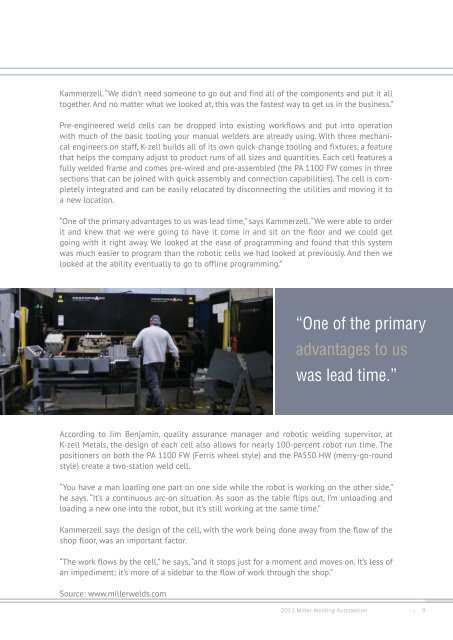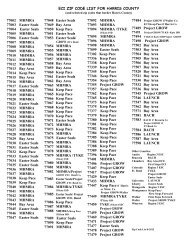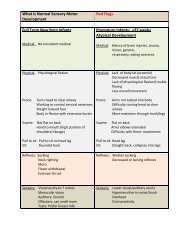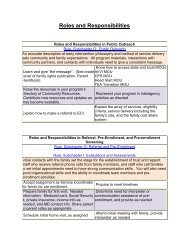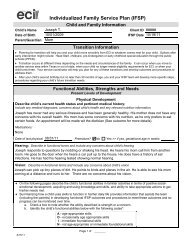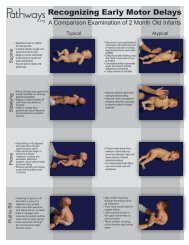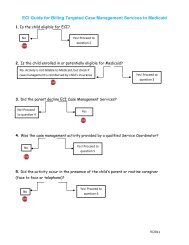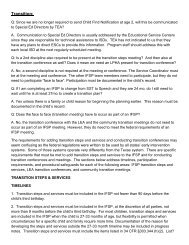Case StudyK-zell Metals Diversifies with Pre-Engineered Robotic Welding Cells;Achieves Faster Part Start-up,Increased Throughput, ProductionEfficienciesAt a time when manufacturers are lookingfor new ways to diversify and competeagainst global competition, K-zell Metals, Inc.of Phoenix has been proactive in anticipatingchanges in the market through processimprovement. The specialty fabrication andcontract manufacturing business was startedin 1986 by Don Kammerzell, a metallurgicalengineer with more than 40 years experiencein steel fabrication.“About ten years ago, we started gettinginvolved in military work, and rapidly noticed“This was the fastest way toget us in the business.”that our business model was changing frombeing the traditional job shop into a contractmanufacturing facility,” says Kammerzel. “Aswe looked at the work that was out there, wesaw that there was a need for more preciseassemblies in the work that we were doing.We found that if we combined a laser, CNCpress brakes and a robotic welding cell, wecould be much more competitive in the marketplace.The combined precision of the laserand CNC press brakes allowed us to fixtureour parts properly, so robotic welding madea lot of sense.”Through the addition of two MillerPerformArc pre-engineered robotic weldcells, K-zell was able to substantially increaseproductivity (by more than 20 percent),reduce set-up time and find new efficienciesin its welding processes — even on relativelyshort production runs. A modular designallowed each system to be quickly droppedinto the flow of the shop floor, and featuressuch as offline programming have helpedthe company quickly take on new work withminimal start-up time.Implementing a Robotic Welding SolutionAs Kammerzell puts it, “I’m really not afraidof too many metals.” K-zell’s global customerbase requires the company to be well versedin everything from mild steels and HSLAs tostainless and aluminum — the company alsodoes a sizable amount of work with siliconbronze. Much of the work put through itsrobotic cells is parts for military and commercialproducts, ranging from basic mild carbonsteel to 4130 chrome-moly. Run sizes rangeas high as 4,000 to 5,000 parts. Precision iscritical as many of the parts K-zell fabricatesare sub-assemblies that must fit perfectlyinto larger structures. In selecting a roboticwelding solution, K-zell needed a systemsuitable for varying run sizes that couldbe programmed quickly and efficiently, andcould also handle varying thicknesses andtypes of alloys. The two PerformArc cells currentlyat work in the company’s plant are thePA 1100 FW and PA 550 HW with advanced350-amp TAWERS robotic welding systemsfrom Panasonic. (Miller and PanasonicWelding Systems Co., Ltd., entered into astrategic teg partnership in 2010 to form a newbusiness unit within Miller — Miller WeldingAutomation — designed to deliver theseproducts to market as a complete automatedwelding system).200200200201“What we really found was that there was acost advantage to selecting a pre-engineeredsystem because it was already done,” says8 2013 Miller Welding Automation www.millerwelds.com
Kammerzell. “We didn’t need someone to go out and find all of the components and put it alltogether. And no matter what we looked at, this was the fastest way to get us in the business.”Pre-engineered weld cells can be dropped into existing workflows and put into operationwith much of the basic tooling your manual welders are already using. With three mechanicalengineers on staff, K-zell builds all of its own quick-change tooling and fixtures, a featurethat helps the company adjust to product runs of all sizes and quantities. Each cell features afully welded frame and comes pre-wired and pre-assembled (the PA 1100 FW comes in threesections that can be joined with quick assembly and connection capabilities). The cell is completelyintegrated and can be easily relocated by disconnecting the utilities and moving it toa new location.“One of the primary advantages to us was lead time,” says Kammerzell. “We were able to orderit and knew that we were going to have it come in and sit on the floor and we could getgoing with it right away. We looked at the ease of programming and found that this systemwas much easier to program than the robotic cells we had looked at previously. And then welooked at the ability eventually to go to offline programming.”“One of the primaryadvantages to uswas lead time.”According to Jim Benjamin, quality assurance manager and robotic welding supervisor, atK-zell Metals, the design of each cell also allows for nearly 100-percent robot run time. Thepositioners on both the PA 1100 FW (Ferris wheel style) and the PA550 HW (merry-go-roundstyle) create a two-station weld cell.“You have a man loading one part on one side while the robot is working on the other side,”he says. “It’s a continuous arc-on situation. As soon as the table flips out, I’m unloading andloading a new one into the robot, but it’s still working at the same time.”Kammerzell says the design of the cell, with the work being done away from the flow of theshop floor, was an important factor.“The work flows by the cell,” he says, “and it stops just for a moment and moves on. It’s less ofan impediment; it’s more of a sidebar to the flow of work through the shop.”Source: www.millerwelds.com2013 Miller Welding Automation9


